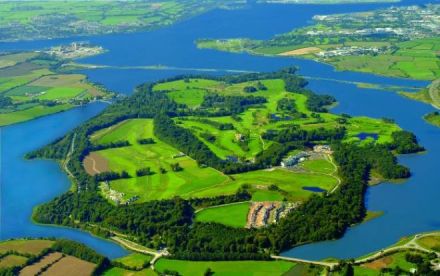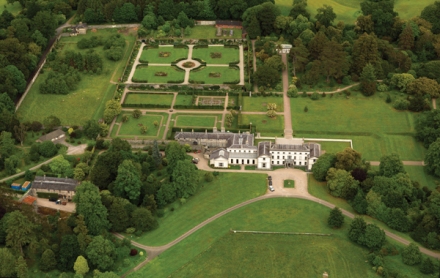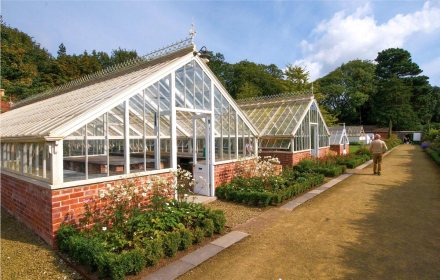
Fota Island from the north east. The main approach road comes from the bottom right and runs along the shore to the south of the island towards Belvelly bridge on the upper left of the picture. The Cork to Cobh rail line is actually the thin line running across the water at the top of the picutre. It just touches Fota at the extreme western tip of the island. Manning Martello Tower is situated on its own ‘island’ at the top of the picture between Fota and Marino Point on Great Island (upper left). .
Irish placenames usually have some meaning….even if the intervening years have bowdlerised the name and left us all confused. For example, the townland of Ballintotis/Ballintotas just three miles east of Midleton has caused a lot of confusion, and not only in terms of its spelling. When Paul McCotter and Kenneth Nicholls edited the Pipe Roll of Cloyne in 1997 they added detailed explanatory notes which give a very reasonable and plausible explanation of the name Ballintotis/Ballintotas. It is actually Baile an tSátair, a name derived from the Anglo-Norman family called des Autier in French or de Altaribus in Latin. They were the landlords from 1177 to the early/mid-1400s. The surname probably still survives in the area as Waters or Sawter.
Another local name in East Cork is Fota. This is a mostly flat island located between Carrigtwohill and Great Island. The island consists of two townlands, each in a different civil parish!

Fota House by Richard and William Vitruvius Morrison is situated amidst fine gardens and a celebrated arboretum.
Fota is best known for the lovely Fota House. This was originally a hunting lodge that was rebuilt and extended in the 1820s as a grand Regency-style mansion by Richard Morrison and his son William Vitruvius. The house is now in the care of the Irish Heritage Trust and is open to the public. Attached to the house are gardens which incorporate Fota’s famous arboretum. The present house was commissioned by John Smith-Barry who also began to develop the gardens and arboretum. He also began the planting of trees around the edge of the demesne which helped to give Fota its famously mild micro-climate.
The other famous feature of Fota is the wildlife park – the first to be established in Ireland. This is the most popular visitor amenity in County Cork. The wildlife park is involved in the conservation of rare and endagered species, particularly cheetahs, red pandas, scimitar horned oryx, Asian lions and, more recently, tigers.
The third element in Fota is the combination of Fota Island Resort and its golf course. The gold course hosted the Murphy’s Irish Open in 2001 and 2003.
One intriguing element of Fota is that it has its own railway halt – as a condition of the sale of the route for the construction of the railway to Queenstown in 1860-62, the Smith-Barrys required that all trains must stop at Fota!

Manning or Fota Martello Tower is situated on a flat island connected to both Fota and Great Island by the railway embankment. Manning Tower was the only one ever taken by an enemy when the Fenians seized it and stripped it of its arms in December 1867, almost 150 years ago!.
One claim to fame that Fota has refers to the Martello tower built at the tip of the Island facing the ntrance from the lower harbour. Manning Tower was actually successfully raided in December 1867 by a party of Fenians – the only Martello tower to be successfully attacked by an enemy! Bizarrely this incident led to the official disarming of all Irish Martello towers in 1868.
There is however one oddity about Fota that is worth exploring – it’s name. The official cartographical name of the island is Foaty. And therein lies a clue to the origins of the seemingly Italian name presently used. The older form of the name suggests a Norse or Vicking origin.

Fota’s superbly restored Frameyard is one of the most popular attractions in the gardens.
The British Museum’s website has an intriguing page created as part of its recent Vikings – Life and Legend exhibition. The page looks at Norse (Viking) placenames in Britain and Ireland. Fota is given two possible meanings. It may be derived from the word fótr, or foot in Norse. This makes sense as the island was indeed a stepping stone, a link, between the mainland to the north and Great Island to the south. However, the other meaning that is offered begs serious questions: fod means female genitalia or anus! The word -ay or -ey was added, meaning island. Frankly, it is difficult to see where the idea of Fota being derived from female genitalia derives from – it makes no sense in a local context. There’s no doubt that the island has a Norse name….but it may have a very ordinary origin.
In 1997 the UCC scholar Donnchadh Ó Corráin examined the meaning of the name.Ó Corráin is clear about one thing, and that is the name Fota certainly has nothing to do with female genitalia, despite the success of breeding endangered animals! Indeed Ó Corráin has examined and rejected the possible Irish alternatives, which include fód thige (sod house), fódh teith (warm soil – a pretty good option), feóidhte (decayed/withered). O Corrain has noted that some of the medieval versions of the name have the letter ‘r’ included in the spelling, suggesting that fódr/fodri, or foot, is indeed the actual origin of the name.

Fota Wildlife Park may be famed for the fertility of its breeding programme for endangered animals, but the origin of the name almost certainly has noting to do with female genitals.
Of course there ARE rude names in East Cork. One is the name surname Cott. This is not derived from the word cott or small fishing boat. It is derived from the Anglo-Norman name Codd, which is still common in County Wexford. Codds are, of course, testicles!
Note: Donnchadh Ó Corráin’s scholarly exploration of the name Fota is found in the journal Peritia, 1997..

